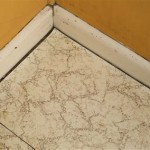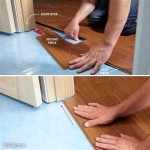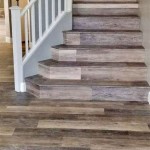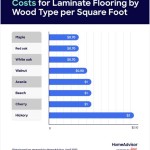Plank Tile Flooring Cost: A Comprehensive Guide
Plank tile flooring has become increasingly popular due to its durability, aesthetic appeal, and versatility. It provides the look of hardwood or stone without the maintenance and cost associated with natural materials. Understanding the cost factors involved in plank tile flooring installation is crucial for homeowners planning a renovation or new build. This article will delve into the various aspects of plank tile flooring cost, including material prices, labor expenses, and other contributing factors.
Material Costs: Understanding Plank Tile Varieties and Pricing
The cost of plank tile flooring primarily depends on the type of material selected. Plank tiles are typically available in three main materials: ceramic, porcelain, and luxury vinyl tile (LVT). Each material offers different advantages and price points.
Ceramic plank tiles are generally the most affordable option. They are made from clay that is kiln-fired and often glazed for protection. Ceramic tiles are suitable for areas with low to moderate traffic and are resistant to stains. The price of ceramic plank tiles typically ranges from $1 to $5 per square foot. This price range can vary based on factors such as the tile's design, size, thickness, and manufacturer. More intricate designs or larger tile formats may command higher prices.
Porcelain plank tiles are a more durable and water-resistant alternative to ceramic. Porcelain is also kiln-fired, but at higher temperatures, resulting in a denser, less porous material. This makes porcelain ideal for areas prone to moisture, such as bathrooms, kitchens, and basements. Porcelain tiles are also more resistant to wear and tear, making them suitable for high-traffic areas. The cost of porcelain plank tiles generally falls between $3 and $10 per square foot. Again, price variations are influenced by style, size, quality, and the complexity of the design.
Luxury Vinyl Tile (LVT) plank flooring offers a different set of advantages. LVT is a synthetic material that mimics the appearance of wood or stone through realistic photographic layers and textured surfaces. LVT is known for its water resistance, ease of installation, and comfort underfoot. High-quality LVT can be exceptionally durable and long-lasting. LVT plank tiles typically cost between $2 and $7 per square foot, depending on the thickness of the wear layer and the quality of the construction. Some high-end LVT products can exceed this range.
Beyond the base material, the design and finish of the plank tile will also affect the cost. Textured finishes, realistic wood grain patterns, and specialty glazes can increase the price. Larger plank sizes, such as 8x48 inches or 6x36 inches, are often more expensive than smaller, more standard sizes. It's essential to consider the desired aesthetic and functional requirements when selecting plank tile materials and factoring in the associated costs.
Tile ratings also influence the long-term cost. Consider the PEI (Porcelain Enamel Institute) rating, which measures a tile's resistance to abrasion. Higher PEI ratings indicate greater durability and are suitable for high-traffic areas, potentially justifying a higher upfront cost. Similarly, water absorption rates are crucial, particularly for wet areas; low absorption rates indicate better water resistance and reduced risk of damage.
When calculating the total material cost, it is recommended to add an overage of approximately 10-15% to account for cuts, waste, and potential future repairs. This buffer ensures that enough material is available to complete the installation without running short.
Labor Costs: Installation Processes and Associated Expenses
Labor costs constitute a significant portion of the overall plank tile flooring expense. The installation process involves several steps, including surface preparation, tile layout, cutting, setting, grouting, and sealing. The complexity of the installation and the experience of the installer will influence the final labor cost.
Surface preparation is a critical step to ensure a successful plank tile installation. The subfloor must be clean, level, and structurally sound. This may involve removing existing flooring, patching cracks, leveling uneven surfaces, and applying a suitable underlayment. The cost of surface preparation can range from $1 to $4 per square foot, depending on the extent of the work required. For instance, removing old tile can be more time-consuming and costly than removing carpet.
Tile layout involves planning the arrangement of the tiles to achieve the desired aesthetic and minimize cuts. This process requires careful measurement and consideration of the room's dimensions. Complex patterns, such as herringbone or diagonal layouts, require more skill and time, resulting in higher labor costs. Standard, straightforward layouts are generally less expensive to install.
The actual tile setting process involves applying adhesive mortar to the subfloor and carefully positioning each tile. Precision and attention to detail are crucial to ensure proper alignment and spacing. Cutting tiles to fit around obstacles or along walls adds to the labor time. The average cost for tile setting ranges from $4 to $10 per square foot, depending on the complexity of the job and the installer's experience. Installers with extensive experience and specialized skills typically charge higher rates.
Grouting involves filling the spaces between the tiles with grout. The type of grout selected can impact the cost, as epoxy grouts are more expensive than cement-based grouts but offer superior stain resistance and durability. Grouting costs typically range from $1 to $3 per square foot. Sealing the grout is also necessary to protect it from moisture and stains. This is usually included in the grouting service but can be an additional cost if performed separately.
The location of the installation also affects labor costs. Installing plank tile in a small bathroom with numerous cuts and corners will be more expensive per square foot than installing it in a large, open living room. Similarly, installing tile on stairs or walls requires specialized skills and will increase the labor costs. Geographic location also plays a role, as labor rates vary depending on the region and the demand for skilled installers.
Obtaining multiple quotes from qualified installers is recommended to ensure competitive pricing and quality workmanship. Checking references and reviewing portfolios can help homeowners select an installer with the necessary experience and expertise. Licensed and insured installers offer added protection against potential liabilities and ensure compliance with local building codes.
Additional Costs: Subfloor Preparation, Tools, and Disposal Fees
Beyond the material and labor costs, several additional expenses should be considered when budgeting for plank tile flooring. These include subfloor preparation, tools and supplies, and disposal fees.
As mentioned previously, subfloor preparation is crucial for a successful tile installation. Depending on the existing subfloor's condition, additional work may be required. This could include installing a new underlayment, repairing or replacing damaged subfloor, or applying a self-leveling compound to create a perfectly flat surface. The cost of these services can vary significantly depending on the extent of the work needed.
Tools and supplies represent another category of expenses. While professional installers typically provide their own tools, homeowners who opt for DIY installation will need to purchase or rent the necessary equipment. This includes a tile saw, trowel, grout float, sponge, level, measuring tape, and safety gear. The cost of these tools can range from a few hundred to several thousand dollars, depending on the quality and type of equipment selected. Alternatively, renting tools can be a more cost-effective option for one-time projects.
Disposal fees are often overlooked but can add to the overall cost. Removing and disposing of old flooring, debris, and waste materials can incur significant charges, especially if large quantities are involved. Some municipalities have specific regulations regarding the disposal of construction waste, which may require hiring a professional waste removal service.
Other potential costs include trim and molding to finish the edges of the tile installation. These can be made of wood, vinyl, or metal and are used to create a seamless transition between the tile and adjacent surfaces. The cost of trim and molding depends on the material, style, and quantity required.
Permits may also be required for tile flooring installations, particularly for larger projects or those involving structural modifications. Checking with local building authorities is essential to ensure compliance with regulations and avoid potential fines. Permit fees vary depending on the location and the scope of the project.
Finally, it's prudent to factor in a contingency fund to cover unexpected expenses that may arise during the installation process. This could include uncovering hidden damage to the subfloor, encountering plumbing or electrical issues, or needing to make adjustments to the tile layout. A contingency fund of 5-10% of the total project cost can provide a buffer against unforeseen circumstances.
By carefully considering all these cost factors, homeowners can develop a realistic budget for plank tile flooring installation and avoid potential financial surprises. Thorough planning and research are essential to making informed decisions and achieving a satisfactory outcome.

Hdb Flooring Vinyl Vs Tile Laminate Parquet Vsscreed

Wood Look Tile Vs Which Flooring Is Better Pros And Cons

Wood Look Tile Flooring Styles Installation Costs

Tile Vs Wood Flooring Major Differences Pros Cons And Costs Forbes Home

How Much Does Flooring Installation Cost 2024 Guide

Cost To Install Vinyl Plank Flooring A Complete Guide For 2024 Forbes Home

The Cost Of Vinyl Plank Flooring Carpet Call

How To Choose The Right Wooden Flooring Cost Maintenance Lifespan

Porcelain Wood Look Tile Vs Luxury Vinyl Plank An Honest Comparison

Average Cost Of Vinyl Flooring Installation In 2024 Forbes Home
Related Posts








